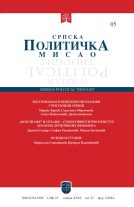- Home page
- Researchers
- Dušan Pavlović
Dušan Pavlović
Faculty of Political Science, University of Belgrade

HOW MUCH LOCAL CULTURAL POLICY COSTS. ANALYSIS OF THE BUDGET OF THE CITY OF KRAGUJEVCA
The research belongs to the field of analysis of public policies and public finances, that is, the analysis of budget funds allocated by the local community for cultural policy. Within that question, the research tries to determine whether there are measurable indicators for determining the success of public policy, and whether budget projects create new value that benefits the local community. The goal of the analysis is to offer budget users to organizations with analytical and research knowledge that enables a deeper insight into the implementation of local public policies.

ASSURANCE GAME IN LARGE GROUPS
I look into assurance games in large groups (more than two players). After discussing a typical two-player example, I show the differences between the game in smaller and larger groups by focusing on the assurance that all the members of the collective will do the same. I discuss four examples: voting in committees, participation in street protest, electoral voting for smaller parties, and participation in a resistance movement. I claim that each of these instances of large group assurance games require different type of focal point to overcome collective action problem. Voting in committees requires a pivot, street protest require a specific type of participants, voting for smaller parties require political optimism among party members and voters, and joining resistance movement requires specific types of norms and communities that guarantee safety in number.

The Budget Dilemma and Public Spending: Evidence from Ten Postcommunist Countries
The paper examines whether the number of parties in the cabinet and the type of coalition affect the level of public spending. It offers a statistical analysis of two hypotheses: (1) the larger the number of parties in the cabinet, the higher the public spending; (2) minority and minimal winning coalitions tend to spend more, whereas large majority coalitions tend to spend less. The analysis draws on statistical data from ten East-Central European countries, with the data confirming the first and rejecting the second hypothesis. The paper offers two novelties. First, it defines a new concept (the Budget Dilemma) to test the relationship between the number of parties and the level of public spending. Second, it uses data about the countries that has appeared less frequently in similar types of research and studies, providing new observations for testing the relationship between the number of the parties in a cabinet and the level of public spending.

The Budgetary Process: An Analysis of the Legislative Measures in Serbia and Croatia
This paper looks into the effects of political institutions on government fiscal policy. Our aim is to establish whether a legislative body has the power to influence the budget proposal tabled by the government. This leverage is measured in the analysis of the six indicators (so-called Wehner scale) which combined, make up the index of parliamentary power in Serbia and in Croatia. In the final section, the results obtained from our analysis are presented in a comparative perspective. Our assessment refers exclusively to legislative measures, not practice.

How Democratic Institutions Emerge
The paper discusses the emergence of democratic institutions. It assumes that institutions can be created if they are compliance-inducing, and tries to answer the question when and why institutions bring about compliance. The paper is divided into two parts. In the first part, I discuss the emergence of institutions generally by applying the concept of the social dilemma. In the second part, I look into the compliance-inducing capability of democratic institutions.

